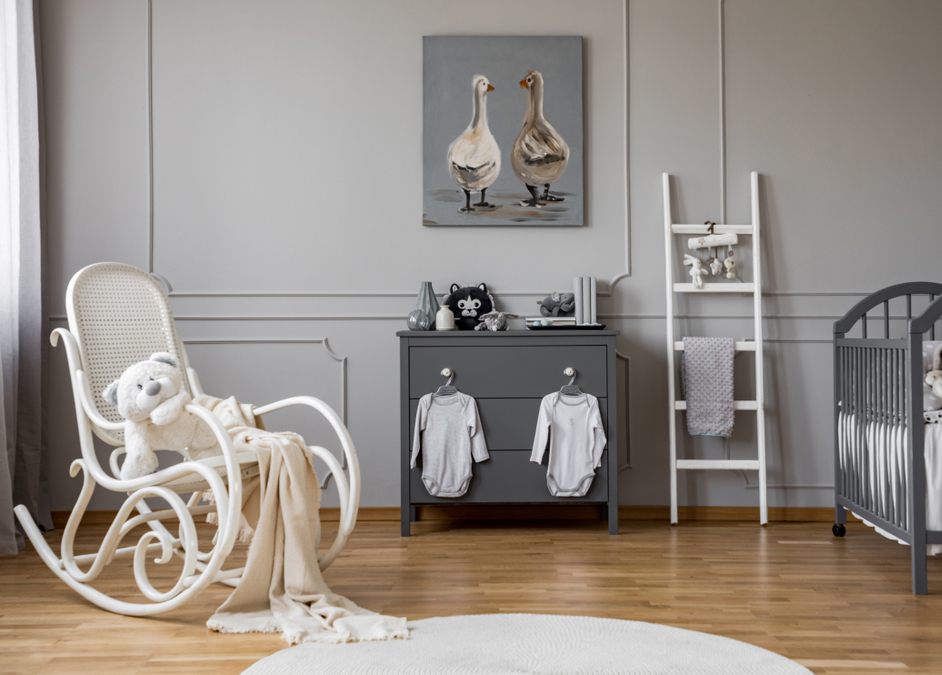Now that the clocks have been turned back and daylight hours have shortened considerably, our homes have become a refuge to escape the colder weather. And that includes your baby’s nursery, where creating a snug environment is essential for a restful (and comfortable) naptime and bedtime.
To help you get in gear for the coming season, interior design experts share their secrets for decorating children’s rooms with practical design elements that ward off winter’s chill—and look good while doing it.
Snug as a Bug
To maintain the element of warmth without overheating a child’s room, begin at the bottom by layering rugs or swapping in a larger one. “Shaggy rugs can be cozy to the touch and doubling up can keep cooler wood floors, especially drafty ones, a layer away,” says Jennifer Morris of JMorris Design (www.jmorrisdesign.com). “Consider a faux sheep skin rug on top of existing flooring for tummy time.”
As your eyes glance upward, you may notice gauzy, sheer curtains that boded well in spring and summer don’t offer the same level of warmth. To maintain a comfortable temperature, update this space with drapes that feature black-out liners. “Not only do drapery panels add beauty, texture and interest to a room, but they can be closed during the night and block light during daytime naps,” says Pamela O’Brien of Pamela Hope Designs (www.pamelahopedesigns.com).
When selecting blackout liner options, she recommends choosing panels that are large enough to cover above and both sides of your windows to eliminate light ‘bleed.’ “A common DIY mistake is buying ready-made panels that are too small for your windows,” notes O’Brien. “Depending on your selection, you may need to buy more than one panel per side. You can have them sewn together for a more professional finish.”
For rooms that are especially drafty, Morris recommends lining drapery panels and returning them back to the wall with a U-shaped curtain rod. “It’s great for black outs and a great option if you rent,” she adds.
If you’ll be opting for fabric window treatments and/or blinds, remember to double check the appropriate safety guidelines. “When we do custom window treatments, we will select [flame-retardant] fabric that is NFPA 701-2010,” says Dee Frazier of Dee Frazier Interiors (www.dkorhome.com), citing the standard safety certification for drapes. And if cordless blinds are not an option, be sure to position your baby’s crib away from any windows to minimize potential hazards.
Bedding Basics
Once the mercury drops, a warm blanket and snuggly sheets are ideal for dressing baby’s crib. Interior designer Melissa Barling of Winter Daisy (www.winterdaisy.com) opts for natural bedding materials when outfitting the nursery. “100-percent organic cotton is ideal, and linen is also a great breathable fabric,” she says.
Morris seconds this design tactic. “When getting bedding, I look to natural materials that don’t off gas,” she explains, referring to the impact of select manufactured goods that release chemicals into the air. “Linens, cotton and wool are your best bets. For winter, I would look for linen and wool blends.”
As your child grows and transitions into toddlerhood, you’ll want to swap out crib sheets for a complete bedding set that includes sheets, pillowcases and an extra-toasty comforter. Fashion-forward designs range from the tried-and-true, to more trendy styles. “I recommend sticking with the classics,” says Barling. “Stripes, polka dots and solid natural bedding will always be on trend.”
Whether you have a boy or girl, you’ll appreciate the all-inclusive bedding designs that are currently on the market. “I see a trend to less gender-heavy schemes,” says Morris. “They don’t need to be overly mature in colors, but I do see more sophisticated blends of patterns, colors and concepts.”
In addition to gender-neutral nursery design elements, Frazier is noticing rainbow-influenced bedding with “a pop of bright, bold colors.” She believes this design choice bodes well for transforming a child’s room as he or she matures. “The key is to keep the design neutral,” she says. “You may change a few elements as they grow, but you will not feel that you have to change the entire room every couple of years.”




